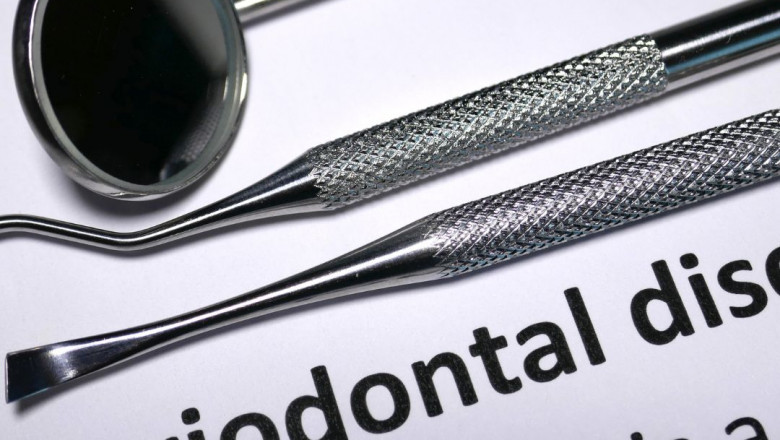views
The 4 Stages of Periodontal Disease: Causes, Symptoms, and Treatments
Gum disease, also known as periodontal disease, is a common yet often overlooked condition that can significantly affect oral and overall health. It progresses in stages, each with distinct characteristics, symptoms, and treatment options. Understanding the stages of periodontal disease is essential for early intervention and long-term dental health.
What Is Periodontal Disease?
Periodontal disease is a chronic inflammatory condition affecting the gums and supporting structures of the teeth. It begins with bacterial accumulation in the mouth due to poor oral hygiene, which leads to plaque and tartar build-up. Left untreated, this can advance through various stages, eventually causing tooth loss and contributing to systemic health problems such as heart disease and diabetes.
Stage 1: Gingivitis
Causes
Gingivitis is the earliest and mildest form of gum disease. It is primarily caused by inadequate oral hygiene, allowing plaque — a sticky film of bacteria — to accumulate on the teeth and gum line. Smoking, hormonal changes, certain medications, and health conditions like diabetes can increase the risk.
Symptoms
- Red, swollen gums
- Bleeding during brushing or flossing
- Bad breath
- Mild gum tenderness
Treatment
Gingivitis is reversible with improved oral hygiene practices such as regular brushing and flossing, professional dental cleanings, and antiseptic mouthwashes. Early detection plays a key role in preventing progression to more severe stages.
Stage 2: Early Periodontitis
Causes
If gingivitis is left untreated, it may progress to early periodontitis. The plaque hardens into tartar, and bacteria begin to damage the supporting structures around the teeth, including the bone.
Symptoms
- Increased gum inflammation
- Gum recession (gums pulling away from the teeth)
- Bleeding gums
- Formation of periodontal pockets (spaces between the teeth and gums)
- Mild bone loss seen on dental X-rays
Treatment
Treatment may involve scaling and root planing — a deep-cleaning procedure that removes plaque and tartar beneath the gum line. Your dentist may also recommend antibiotic treatments to reduce bacterial infection.
Stage 3: Moderate Periodontitis
Causes
At this stage, the infection has spread deeper, causing more significant damage to the bone and periodontal ligaments. Continued neglect or ineffective treatment of early periodontitis often leads to this phase.
Symptoms
- Deeper periodontal pockets
- Moderate to severe gum recession
- Tooth mobility or looseness
- Chronic bad breath
- Increased bone loss
Treatment
More intensive treatments are required, including further scaling and root planing, laser therapy, or minor surgical procedures such as flap surgery to clean infected areas. Bone grafting may be necessary if bone loss is substantial.
Stage 4: Advanced Periodontitis
Causes
Advanced periodontitis is the final and most severe of the stages of periodontal disease. It often results from prolonged, untreated gum disease and is marked by extensive tissue and bone destruction.
Symptoms
- Severe tooth mobility
- Shifting or misaligned teeth
- Significant bone loss visible on X-rays
- Pus discharge from the gums
- Pain when chewing
- Tooth loss
Treatment
Treatment at this stage is complex and typically includes surgical interventions, such as bone grafts, guided tissue regeneration, and even tooth extractions if the damage is irreparable. Dental implants or dentures may be required to replace lost teeth. Long-term maintenance is crucial to prevent further complications.
Preventing Gum Disease
Preventing gum disease starts with daily habits and regular dental visits. Key strategies include:
- Brushing twice a day with fluoride toothpaste
- Flossing daily to remove food particles and plaque between teeth
- Regular dental check-ups and professional cleanings
- Avoiding tobacco use
- Managing underlying health conditions like diabetes
A diet rich in vitamins C and D, along with adequate hydration, also supports gum health.
The Link Between Gum Disease and Overall Health
Research increasingly shows that gum disease doesn’t just affect your mouth. It is associated with a higher risk of systemic conditions like cardiovascular disease, stroke, and even complications during pregnancy. By treating periodontal disease early, you’re also supporting your overall wellbeing.
In summary, the stages of periodontal disease progress from mild gingivitis to severe advanced periodontitis, each with increasing levels of damage and complexity in treatment. Early detection and treatment are key to stopping the progression of gum disease and maintaining lifelong oral health. Regular dental visits, proper oral hygiene, and a healthy lifestyle are the cornerstones of prevention. Taking action at the first sign of trouble can make all the difference — not only for your teeth and gums but also for your general health. If you suspect you may have any symptoms of gum disease, consult your dentist as soon as possible.






















Comments
0 comment